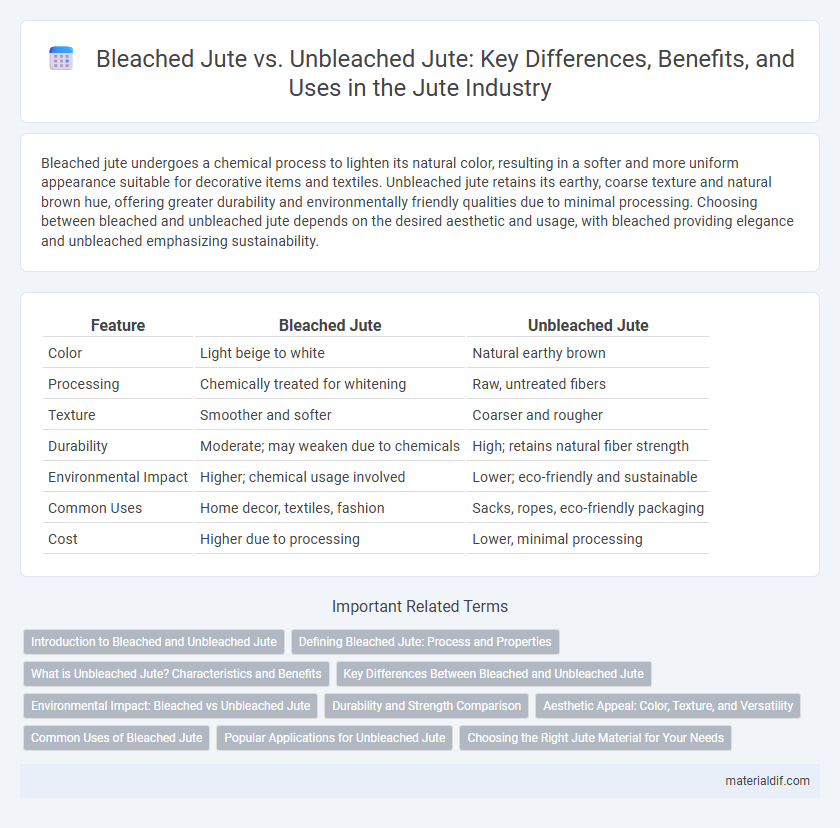Bleached jute undergoes a chemical process to lighten its natural color, resulting in a softer and more uniform appearance suitable for decorative items and textiles. Unbleached jute retains its earthy, coarse texture and natural brown hue, offering greater durability and environmentally friendly qualities due to minimal processing. Choosing between bleached and unbleached jute depends on the desired aesthetic and usage, with bleached providing elegance and unbleached emphasizing sustainability.
Table of Comparison
| Feature | Bleached Jute | Unbleached Jute |
|---|---|---|
| Color | Light beige to white | Natural earthy brown |
| Processing | Chemically treated for whitening | Raw, untreated fibers |
| Texture | Smoother and softer | Coarser and rougher |
| Durability | Moderate; may weaken due to chemicals | High; retains natural fiber strength |
| Environmental Impact | Higher; chemical usage involved | Lower; eco-friendly and sustainable |
| Common Uses | Home decor, textiles, fashion | Sacks, ropes, eco-friendly packaging |
| Cost | Higher due to processing | Lower, minimal processing |
Introduction to Bleached and Unbleached Jute
Bleached jute undergoes a chemical process to remove natural color and impurities, resulting in a lighter, more refined appearance ideal for decorative textiles and finer applications. Unbleached jute retains its natural brownish hue and coarse texture, making it suitable for eco-friendly packaging, sacks, and rustic home decor. Both types offer durable, sustainable fibers with distinct aesthetic and functional properties tailored to different industry needs.
Defining Bleached Jute: Process and Properties
Bleached jute undergoes a chemical treatment that removes natural pigments, resulting in a lighter, uniform color suitable for high-quality textiles and decorative applications. This process typically involves the use of bleaching agents like hydrogen peroxide or sodium hypochlorite, which enhance the fiber's brightness and softness without compromising its durability. Bleached jute retains the essential strength and biodegradable properties of natural jute while offering improved aesthetic appeal and increased versatility for various industrial uses.
What is Unbleached Jute? Characteristics and Benefits
Unbleached jute is a natural fiber derived from the jute plant that retains its original brownish-yellow color and coarse texture due to the absence of chemical whitening processes. This fiber is highly valued for its eco-friendliness, durability, and breathability, making it ideal for sustainable packaging, upholstery, and agricultural uses. Unbleached jute's minimal processing preserves its lignin content, enhancing strength and resistance to wear while maintaining biodegradable properties.
Key Differences Between Bleached and Unbleached Jute
Bleached jute undergoes a chemical treatment process that removes natural color and impurities, resulting in a lighter, more uniform appearance, while unbleached jute retains its original brownish tone with higher natural fiber strength. Bleaching affects the texture by making bleached jute softer and less coarse, suitable for fine textiles and decorative products, whereas unbleached jute maintains its roughness and durability favored for industrial uses like sacks and ropes. The environmental impact also differs, as unbleached jute is more eco-friendly due to the absence of chemical processing involved in bleaching.
Environmental Impact: Bleached vs Unbleached Jute
Unbleached jute retains its natural fibers, reducing the need for chemical processing and minimizing water pollution compared to bleached jute, which involves chlorine-based agents that can release harmful compounds into waterways. The environmental footprint of unbleached jute is significantly lower due to its lower energy consumption and reduced chemical waste during manufacturing. Choosing unbleached jute supports sustainable practices by preserving soil health and promoting biodegradability without the added environmental burden of bleaching processes.
Durability and Strength Comparison
Bleached jute undergoes a chemical treatment that removes natural impurities, resulting in a lighter color but slightly reduced fiber strength and durability compared to unbleached jute. Unbleached jute retains its natural lignin content, providing superior tensile strength and enhanced resistance to wear and environmental factors. For applications requiring maximum durability and robustness, unbleached jute is generally preferred due to its intact fiber integrity.
Aesthetic Appeal: Color, Texture, and Versatility
Bleached jute offers a lighter, more uniform color and smoother texture, enhancing its appeal for modern, clean designs, while unbleached jute retains its natural earthy tones and rough texture, providing a rustic and organic aesthetic. The versatility of bleached jute suits contemporary interiors and fashion applications requiring a refined look, whereas unbleached jute is favored for eco-friendly products and traditional crafts where authenticity and natural appearance are key. Color retention, texture consistency, and adaptability to dyes and finishes distinctly set bleached jute apart from its unbleached counterpart in aesthetic applications.
Common Uses of Bleached Jute
Bleached jute is commonly used in the production of textiles, home decor, and fashion accessories due to its lighter color and smoother texture, which enhance aesthetic appeal. It is favored for crafting items such as curtains, upholstery, and bags where a clean, uniform appearance is desired. In contrast to unbleached jute, bleached jute provides a neutral base suitable for dyeing and printing, broadening its application in decorative and industrial products.
Popular Applications for Unbleached Jute
Unbleached jute retains its natural golden hue and coarse texture, making it ideal for eco-friendly applications such as burlap sacks, bioplastic composites, and landscaping fabric. Its durability and biodegradability support sustainable packaging solutions and erosion control in agriculture. Popular uses also include upholstery backing, carpet backing, and wall coverings where strength and natural aesthetics are important.
Choosing the Right Jute Material for Your Needs
Bleached jute offers a lighter, more uniform appearance ideal for decorative uses and products requiring a clean finish, while unbleached jute retains its natural brown color and strength, making it suited for eco-friendly packaging and industrial applications. Consider bleached jute for aesthetic appeal in crafts and upholstery, whereas unbleached jute is preferable for durable sacks, ropes, and sustainable horticultural uses. Selecting the right jute depends on the balance between visual requirements and functional durability tailored to your specific project demands.
Bleached Jute vs Unbleached Jute Infographic

 materialdif.com
materialdif.com